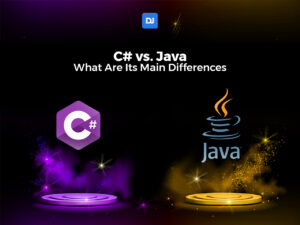Machine Learning (ML) software is one of the fastest-growing segments of the software industry, and anyone serious about building an ML application needs to choose the best language. Python is best for quick prototyping and production, R for heavy statistics and plots, Java for rock-solid enterprise systems, C++ when every microsecond matters, Julia for high-performance scientific workloads, and Scala to run massive Spark pipelines.
If you’re looking to hire developers in machine learning, you must keep in mind that expertise and experience in programming are fundamental to applying machine learning models successfully. Knowledge of core programming languages and their prominent aspects such as algorithms, data structures, logic, and memory management is essential for the best machine learning results.
In this article, we look at some of the best machine learning programming languages available in 2025.
What is Machine Learning?
Machine learning falls under the domain of artificial intelligence. It enables software programs to improve their ability to anticipate outcomes without being programmed to do so. To forecast new output values, machine learning algorithms utilize past data as input.
Machine learning development encompasses a wide array of tasks, including data ingestion and preprocessing, exploratory data analysis, feature engineering, model training and evaluation, and finally, deployment and monitoring. The programming language and its associated ecosystem can significantly streamline or complicate each of these stages.
A language with rich, specialized libraries can accelerate development, while one with strong performance characteristics can be crucial for training large models or serving predictions with low latency.
The following is a list of the top ten programming languages for machine learning.
Top 6 languages for Machine Learning in 2025
Since different tasks require different considerations, choosing the best ML language isn’t one-size-fits-all, it hinges on the task at hand, performance demands, your team’s skills, current stack, and where the project sits in its lifecycle. For example, use R for deep statistical research, C++ for ultra-fast models on tiny devices, and Python (with a bit of JavaScript) when you need to whip up an ML-powered web app quickly. Let’s dive in:
1. Python
Python can power complicated scripting and online applications, making it a perfect choice for beginners and expert developers alike. It is a general-purpose programming language that was developed in 1991.
Because of its simplicity and ease of use, it has long been a favorite among developers. It is used with a variety of different frameworks and libraries.
It’s no surprise that Python engineers are in high demand since it’s one of the most sought-after languages in machine learning, data analytics, and web development. Python is a popular programming language because it provides a wide range of options for coding.
Multiple visualization packages and important core libraries like sklearn and seaborn are available because of their open-source nature and scalability. These powerful libraries make coding a breeze and allow machines to learn more.
Programming models supported by Python include object-oriented, functional, imperative, and procedural. Both TensorFlow and Scikit are pretty popular among Python developers when it comes to machine learning frameworks.
Advantages for ML
Python offers a compelling set of features that cater to the machine learning workflow:
- Ease of Learning and Readability
- Extensive Ecosystem of Libraries & Frameworks
- Versatility
- Platform Independence
- Rapid Prototyping
Disadvantages and Limitations for ML
Despite its strengths, Python has limitations, particularly concerning performance:
- Slow Execution Speed
- Global Interpreter Lock (GIL)
- High Memory Consumption
- Weaknesses in Mobile and Game Development
- Database Interaction Challenges
The best use case for Python
Python has extensive library support and can be used for almost every machine learning task and stage of the product.
| Model Deployment and MLOps |
| Developing and training neural networks for complex tasks like image recognition (Computer Vision), speech recognition, and NLP using TensorFlow, Keras, and PyTorch. |
| Natural Language Processing |
| Data Preprocessing and Cleaning- Using Pandas and NumPy for loading, cleaning, transforming, and preparing data for modeling. |
| Classical Machine Learning: Building models for classification, regression, clustering, and dimensionality reduction with Scikit-learn. |
| Exploratory Data Analysis (EDA) and Visualization: Employing Matplotlib, Seaborn, and Pandas for understanding data patterns, distributions, and relationships. |
2. R: The Statistician’s Powerhouse in the ML Arena
While Python has come to dominate the machine learning software space, R still plays an important role. It is a free, open-source language and environment that specializes in statistical computing and graphics. It also has a large number of resources for building machine learning applications,
Analysts, statisticians, and data miners use R because it is easier to learn than other programming languages. It supports a command-line interface and various IDEs in addition to a wide range of tools for managing libraries and producing better graphs.
It is a graphics-based language that data scientists use to analyze graphs by large corporations, particularly in the biomedical industry.
Representational State Machines (RSMs) such as classification, regression, and decision tree building may be implemented in R. It has been a dynamic, imperative, and functional language because of its statistical and functional properties. In addition to Windows, Linux, and OS X, it can also run on other platforms.
R is currently the 15th most popular programming language as per the Tiobe Index. With such interest in the developer community, you can find skilled R developers easily for your project.
Advantages and Disadvantages for ML
R offers several advantages for statistically-oriented machine learning tasks and faces several limitations when applied to broader or larger-scale machine learning tasks:
| Pros | Cons |
| Strong Statistical Capabilities | Steep Learning Curve (for non-statisticians/non-programmers) |
| Excellent Data Visualization | Memory Management |
| Rich Package Ecosystem (CRAN) | Integration and Deployment Challenges |
| Domain-Specific Strengths | Limited General-Purpose Programming Capabilities |
R Use Cases:
- Advanced Statistical Modeling: Econometrics, time series analysis, survival analysis, mixed-effects models, Bayesian statistics.
- Exploratory Data Analysis (EDA): In-depth investigation of data patterns, distributions, correlations, and outliers.
- Data Visualization: Creating complex, customized, and publication-quality static and interactive graphics
- Academic and Scientific Research: Widely used in universities and research institutions across many disciplines
- Bioinformatics and Computational Biology: Analyzing genomic data, clinical trial data, and other biological datasets.
- Quantitative analysis, risk modeling, and financial forecasting.
- Regression, classification, and decision tree formation, often with a strong emphasis on model interpretability and statistical validation
3. Java – Scaling Machine Learning for the Enterprise
Several machine learning applications and techniques can benefit from Java. While Python typically dominates the model building and experimentation phases of ML, Java’s strength lies in the operationalization of these models. It excels at integrating ML into backend systems, large-scale data processing pipelines (often involving tools like Apache Hadoop and Spark), and existing enterprise software infrastructure.
While Python has far more state-of-the-art research machine learning libraries, there is no shortage of Java libraries to help run and deploy the models, as well as for some specific tasks. A key trend is that Java developers are increasingly focused on connecting to pre-trained foundation models and embedding AI-driven features into production applications, rather than building models from scratch
Advantages and Disadvantages of Java for ML
Java brings several key advantages to enterprise machine learning and also presents certain challenges when considered for core ML development:
| Pros | Cons |
| Java is known for its ability to handle large-scale, high-throughput applications. | Fewer AI-Specific Libraries than Python |
| Platform Independence (WORA – “Write Once, Run Anywhere”) | Java’s syntax is generally more verbose than Python’s |
| Robust Tooling and Ecosystem | Fewer Java Developers with Strong AI/ML Research Backgrounds |
| Strong Security Feature | GPU Acceleration Less Seamless |
| Object-Oriented Paradigm | Steeper Learning Curve for Pure ML Tasks |
Java Use Case:
- Enterprise-Level ML Deployment
- Fraud Detection and Risk Management
- Predictive Analytics in Enterprise Systems
- Big Data Processing with Spark/Hadoop
- Backend Systems for AI-Powered Applications
- Android Application ML Features
- Modern AI Applications
4. C++: High-Performance Computing in Machine Learning
C++ holds a specialized yet critical position in the machine learning ecosystem, primarily valued for its exceptional performance, efficiency, and low-level control over system hardware. While not typically the language of choice for initial ML model development or data exploration due to its complexity, C++ becomes indispensable when raw speed, minimal latency, and resource optimization are paramount
Because these languages are considered low-level languages, computers can read and understand them. Machine learning programs can be installed on IoT devices since it is simple to give hardware-level functionalities.
These kinds of applications benefit significantly from the speed at which they may be completed and delivered. Torch, TensorFlow, etc., are all C/C++ implementations of powerful libraries. Performance-critical applications have found them handy.
C++ offers the ability to alter algorithms and do extensive memory management better than any other programming language. Developers can also fine-tune a wide range of performance settings using this language.
Advantages and Disadvantages of C++ for ML
C++ offers distinct advantages for performance-sensitive ML applications but comes with significant trade-offs:
| Pros | Cons |
| Exceptional Performance | Slower Development and Prototyping Speed: |
| Low-Level Control | Steep Learning Curve and Complexity |
| Memory Management | Smaller High-Level ML Ecosystem |
| Scalability for Computationally Intensive Tasks | Fragmented AI Community |
| Integration with Existing High-Performance Systems | Manual Memory Management Risks |
C++ is typically employed in ML for:
- Real-time Inference: Deploying trained models for applications requiring very fast predictions (e.g., in autonomous systems, real-time bidding).
- Computer Vision: Processing image and video data efficiently for tasks like object detection and tracking.
- Robotics and Autonomous Systems: Implementing perception, planning, and control algorithms that require high performance and low latency.
- Game AI: Developing intelligent agents and behaviors in video games.
- Embedded Machine Learning: Running ML models on resource-constrained devices (e.g., IoT devices, microcontrollers).
- Core ML Framework Development: Building the high-performance computational backends of libraries like TensorFlow and PyTorch.
- Optimizing Critical Code Paths: Rewriting performance-sensitive parts of ML pipelines initially developed in slower languages.
5. Julia: The Aspirant for High-Performance Scientific Computing and ML
Julia was conceived with the ambitious goal of addressing the “two-language problem” in scientific computing, where researchers often prototype in a high-level dynamic language like Python or R and then rewrite performance-critical parts in a low-level language like C or Fortran.
Julia is a popular high-level, dynamic programming language for constructing machine learning applications that are focused on model analytics. It has a simple syntax that makes it a popular choice for programmers since it also offers high performance.
It offers:
- Exceptional numerical accuracy
- An efficient compiler
- Distributed parallel execution
- An extensive library of mathematical functions.
Interactivity is considered a beneficial feature when writing scripts for this language since it runs well on several platforms. It has a huge following because it is functional and object-oriented, making it an excellent option for constructing machine learning applications.
It is free and open-source by design under the MIT license. Julia can function at its best on both the server and the client-side.
It’s an excellent tool for calculating numerical and computational statistics so this is also quite popular amongst data analysts and statisticians.
Advantages and Disadvantages of Julia for ML
| Pros | Cons |
| High Performance | “Time to First Plot” Issue |
| Dynamic Typing with Optional Type Annotations | Learning Curve for Advanced Features |
| Multiple Dispatch | Less Mature Ecosystem |
| Built-in Parallelism | Smaller Community and Lower Market Adoption |
| Julia can directly call C, Fortran, and Python libraries without “glue” code | Documentation Gaps |
| Mathematical Syntax | |
| Growing Ecosystem for Scientific ML |
6. Scala: Powering ML with Big Data through Apache Spark
Scala stands for Scalable Language. It is a compiled, statically-typed language that combines the functionality and features of object-oriented languages and functional programming. It runs on the Java Virtual Machine (JVM) and can connect to Java code and libraries. It’s also a fairly concise language, even more so than Java.
Its biggest claim to fame is that it’s the main language for Apache Spark, which might be the most popular distributed system for handling massive amounts of data.
Advantages and Disadvantages for ML
| Pros | Cons |
| Excellent for Big Data Processing | Smaller Community (than Python/Java) |
| Scalability | Steep Learning Curve |
| Java Interoperability | Niche Focus for ML |
| Functional Programming Features | Tooling Complexity |
| Static Typing |
Scala Use Cases:
- Building robust backend systems for data-intensive applications that incorporate ML features.
- Large-scale machine learning on distributed datasets using Apache Spark (e.g., classification, regression, clustering, recommendation systems).
- Big data analytics and ETL (Extract, Transform, Load) pipelines that feed into ML models.
- Real-time data processing and stream analytics with ML components (e.g., using Spark Streaming or integrating with Kafka/Flink).
Table Comparison of Top Languages for ML
| Language | ML-Ecosystem Maturity | Dev Speed | Exec Speed | Ease of Use | Community | Scalability / Deployment |
|---|---|---|---|---|---|---|
| Python | TensorFlow, PyTorch, scikit-learn, NumPy – unmatched breadth | ★★★★★ | ★★☆☆☆ (fast via C/C++ back-ends) | ★★★★★ | Largest ML dev base | Strong MLOps & cloud; GIL limits CPU-bound threads |
| R | CRAN, Tidyverse, caret – rich stats & viz | ★★★★☆ (stats) | ★★☆☆☆ | ★★★★☆ (statisticians) | Large academic base | Needs extra tooling for scale |
| Java | DL4J, Weka, Spring AI – solid enterprise set | ★★☆☆☆ | ★★★★☆ (JVM) | ★★★☆☆ | Huge enterprise pool | Excellent for big back-ends & Android |
| C++ | mlpack, LibTorch, TF C++ – high-performance cores | ★☆☆☆☆ | ★★★★★ | ★☆☆☆☆ | Smaller, specialised | Optimal for embedded / low-latency |
| Julia | Flux.jl, MLJ.jl – growing HPC focus | ★★★☆☆ | ★★★★☆ (JIT) | ★★★☆☆ | Small, active | Built-in parallelism; great HPC scaling |
| Scala | Spark MLlib – Spark-centric power | ★★★☆☆ | ★★★★☆ (JVM) | ★★☆☆☆ | Spark-focused crowd | Excellent on Apache Spark clusters |
| JavaScript | TensorFlow.js, Brain.js – web-first | ★★★★☆ (web) | ★☆☆☆☆ | ★★★★☆ | Massive web community | Easy browser/serverless demos; browser perf limits |
What Is The Most Widely Used Machine Learning Language?
Let’s start by taking a look at how prevalent machine learning languages are in general. While Python is widely used among data scientists and machine learning engineers, just 33% prioritize its use for development.
It’s no surprise, considering the recent development in Python’s deep learning frameworks, including the introduction of TensorFlow and a broad range of additional libraries, such as PyTorch.
Even though Python and R are often comparable, their popularity gap is steep. Only Python has a higher percentage of Python users than any other programming language, both in use (44%) and priority (44%). Overall, R is used by 31% of the population. Also, only 17% of developers, who use R, prioritize it as their primary programming language for machine learning.
As a result, R is used mostly as a supplementary language rather than the primary one in most situations. Among the most popular languages, Python has the greatest percentage of users.
The Future of Machine Learning Is Bright!
There is no going back for machine learning services and solutions. New and interesting developments in machine learning and artificial intelligence are expected due to the availability of various programming languages and frameworks.
If you’re looking to hire a developer for machine learning, you must have a clear understanding of your project. Your technology team must have a concrete goal and plan before you begin to look for developers.
Many beginner developers prefer Python as the ideal choice due to its extensive library and simplicity of use. So, it is easier to find them if your project demands so.
Regardless of the language you choose, these are exciting times for machine learning. If you’re looking to hire full-time remote developers, contact us. Our team will help you find career-driven, full-time developers that are the perfect match for your industry, time zone, and company culture.





